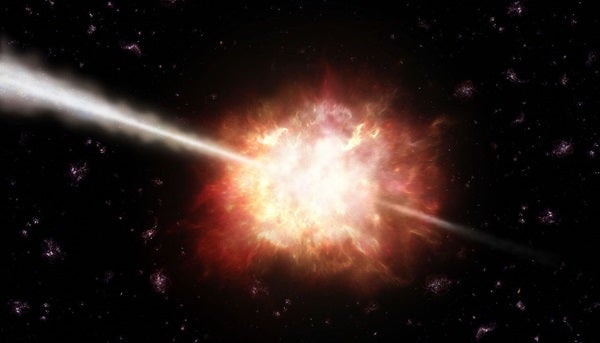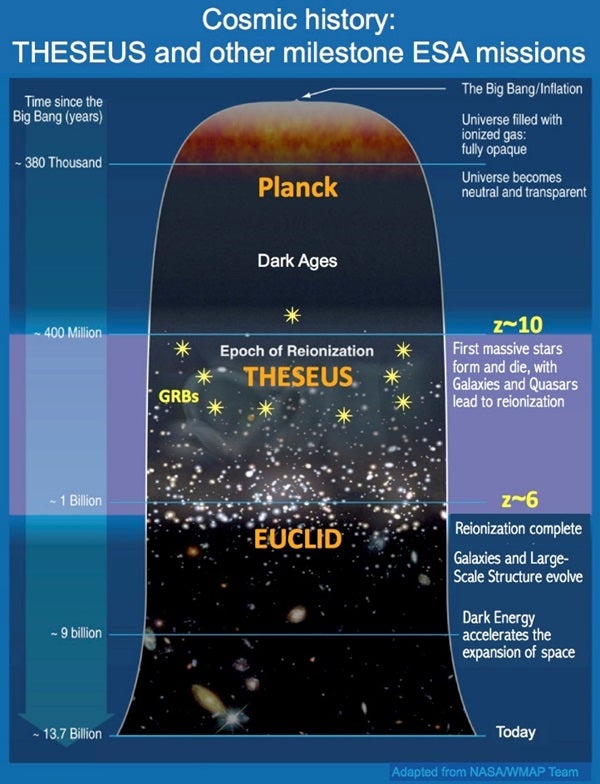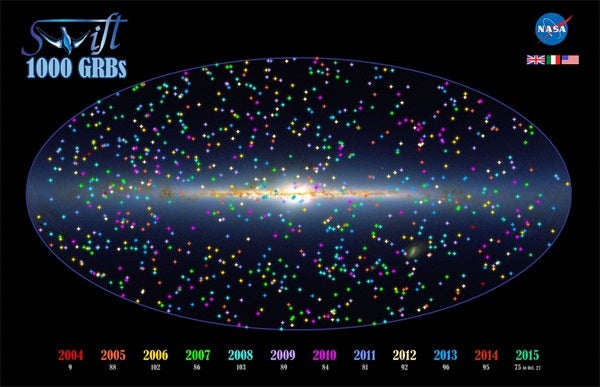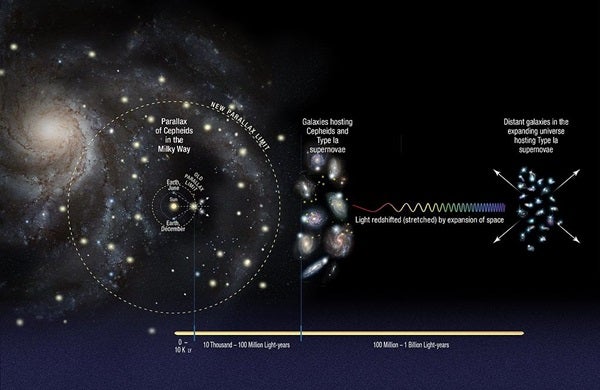Determining distance is one of astronomy’s greatest challenges. For nearby objects, astronomers rely on parallax, which causes nearby stars to shift against the seemingly stationary background of more distant stars. For more than a century, astronomers have relied on so-called standard candles — celestial objects with known absolute luminosities — to calculate distances deemed too far afield for a reliable parallax.
Astronomers first used Cepheid variables — a type of variable star — as standard candles to measure distances throughout our galaxy and to many others. More recently, cosmologists have used Type Ia supernovae as standard candles. Type Ia supernovae are the explosions that occur when a white dwarf (the core of a dead star) pulls material off a companion star and grows too heavy. Because there is a physical limit to how massive a white dwarf can become, these explosions always take place when the star reaches a certain mass and are thus always the same brightness. The resulting explosions are so luminous and reliable that they provided astronomers with precise measurements of the cosmos’ ongoing expansion down to accuracies of some 6 to 7 percent.
That’s pretty accurate, but not accurate enough to separate one theory from another in some cases. So, how can astronomers slice this uncertainty in half?
Perhaps by using gamma-ray bursts, or GRBs.

Want to learn more about pulsars and other extreme objects in our universe? Check out our free downloadable eBook: Exotic objects: Black holes, pulsars, and more.
Introducing: Gamma-ray bursts
GRBs are among the most powerful high-energy events known in the universe. During their short-lived, highest-energy phase, lasting anywhere between a few seconds to a few hours, they emit the same amount of energy the Sun releases over its entire lifetime. A GRB’s primary emissions are high-energy photons such as gamma rays and high-energy X-rays. This is followed by long-lasting GRB afterglow emissions that span the electromagnetic spectrum, from X-rays and optical to infrared and sometimes even radio.
Because they are so energetic, GRBs are easy to spot at enormous distances, says Lowell Observatory astronomer Michael West. But astronomers still aren’t certain as to what causes them. They believe most GRBs occur when a massive star implodes to create a black hole, releasing huge bursts of energy in intense beams, he says.
Despite their immense brightness, “a big challenge with using GRBs as standard candles is that no two are exactly alike,” West says. “GRB light curves show extraordinary diversity.” The blasts vary in length, with some lasting much longer than others. Some show multiple peaks of high emission while others show just one, he says.
All of this suggests that there is probably more than one GRB progenitor, in much the same way that there are multiple types of supernovae, West says. Those possible progenitors include not only the collapse of massive stars, but also the merger of two neutron stars or a neutron star and a black hole, or potentially flares released from magnetars — a class of highly magnetic neutron stars.
Challenges ahead
But it’s not easy to correct for these variations in a reliable way so that GRBs can be used as standard candles. One problem with trying to use GRBs to extend our ability to measure distanct objects is that current space observatories can only spot the most luminous bursts at the greatest cosmic distances.
There’s also the problem of determining a GRB’s distance in the first place. Currently, astronomers must first spot a GRB’s gamma-ray or X-ray emission with a space telescope. Then they must hope another telescope (usually on the ground) can measure its optical or infrared spectrum, or spread-out light, to look for signs that give astronomers its distance, says Paul O’Brien, an astronomer at the University of Leicester in the U.K. But it takes a large telescope to get enough light from an object to measure distance this way, and many GRBs are too short-lived to allow astronomers time to swing a large telescope to the right spot on the sky. Only the longer-lasting GRBs can be followed up.
Because of this challenge, astronomers have only calculated the distance for about 30 percent of the GRBs found by NASA’s Neil Gehrels Swift Observatory, says O’Brien. To get more distances, O’Brien says, we ideally need to both spot GRBs and follow up by getting their spectrum onboard the same spacecraft. This would eliminate the lag between seeing a GRB and getting the information needed to measure its distance.
Meet THESEUS
The European Space Agency has funded an initial study for a high-energy space observatory dubbed the Transient High Energy Sky and Early Universe Surveyor (THESEUS). If fully funded, THESEUS would launch in 2032. THESEUS should find lots of distant GRBs by determining their accurate locations as well as their distances, all without having to rely on ground-based observations. The spacecraft would carry not only a gamma-ray and X-ray detector to spot a GRB when it occurs, but an infrared telescope to immediately observe the same location, get a spectrum, and determine distance.
THESEUS will have the capability of observing in one year the same number of GRBs that have been observed with Swift in 10 years, says Maria Giovanna Dainotti, a Stanford University astronomer and an assistant professor at Jagiellonian University in Poland.
And by looking not only in gamma rays but also in X-rays, O’Brien says, astronomers will find many more extremely distant objects. That’s because, as the universe expands, light becomes stretched out, or redshifted, to lower wavelengths. Gamma rays from bursts at the greatest distances are thus stretched to lower energies, appearing as X-rays.
A new standard?
Astronomers’ ultimate goal is to find a way to make GRBS “standardizable” in the same way that Type Ia supernovae are, says Brad Cenko, an astronomer at NASA Goddard Space Flight Center in Maryland. This, he says, would allow us to use them as standard candles to measure to greater distances than is possible today the locations and motions of galaxies, revealing how the universe is expanding over time.
Additionally, the farther a galaxy lies from us, the earlier into the universe’s history we’re looking when we observe it. Using distant GRBs as standard candles, astronomers believe we could look back to times as early as about 500 million to 1 billion years after the Big Bang — when the first galaxies were just starting to form.
Extending standard candles to greater distances and looking further back in time should also help astronomers solve the mystery surrounding dark energy — the force that’s causing the expansion of the universe to accelerate.
Because dark energy’s contribution varies with time, finding GRBs at greater distances would help researchers get a better understanding of how dark energy evolved over cosmic time. But the crux of such research depends on making GRBs work as standard candles.
Dainotti predicts current research will enable GRBs to be used as standard candles within the next couple of years. The true leap forward will be to find a standard subset of GRBs with common properties, she says, the same way Type Ia supernovae are a subset of supernova explosions.
But Cenko remains skeptical. THESEUS should be great for finding GRBs at high redshift, he says, but without some way to standardize these sources, it won’t be able to say much about dark energy.
Astrophysicists have been studying GRBs for half a century, following their serendipitous discovery in 1969. Much progress has been made in understanding their origins, but efforts to use them as standard candles have progressed slowly. And many astronomers don’t believe GRBs can ever be standardized as tools to measure cosmic distances. But thanks to current efforts, which include the development of observatories like THESEUS, there are signs that these events may someday become a rung on our cosmic distance ladder.













